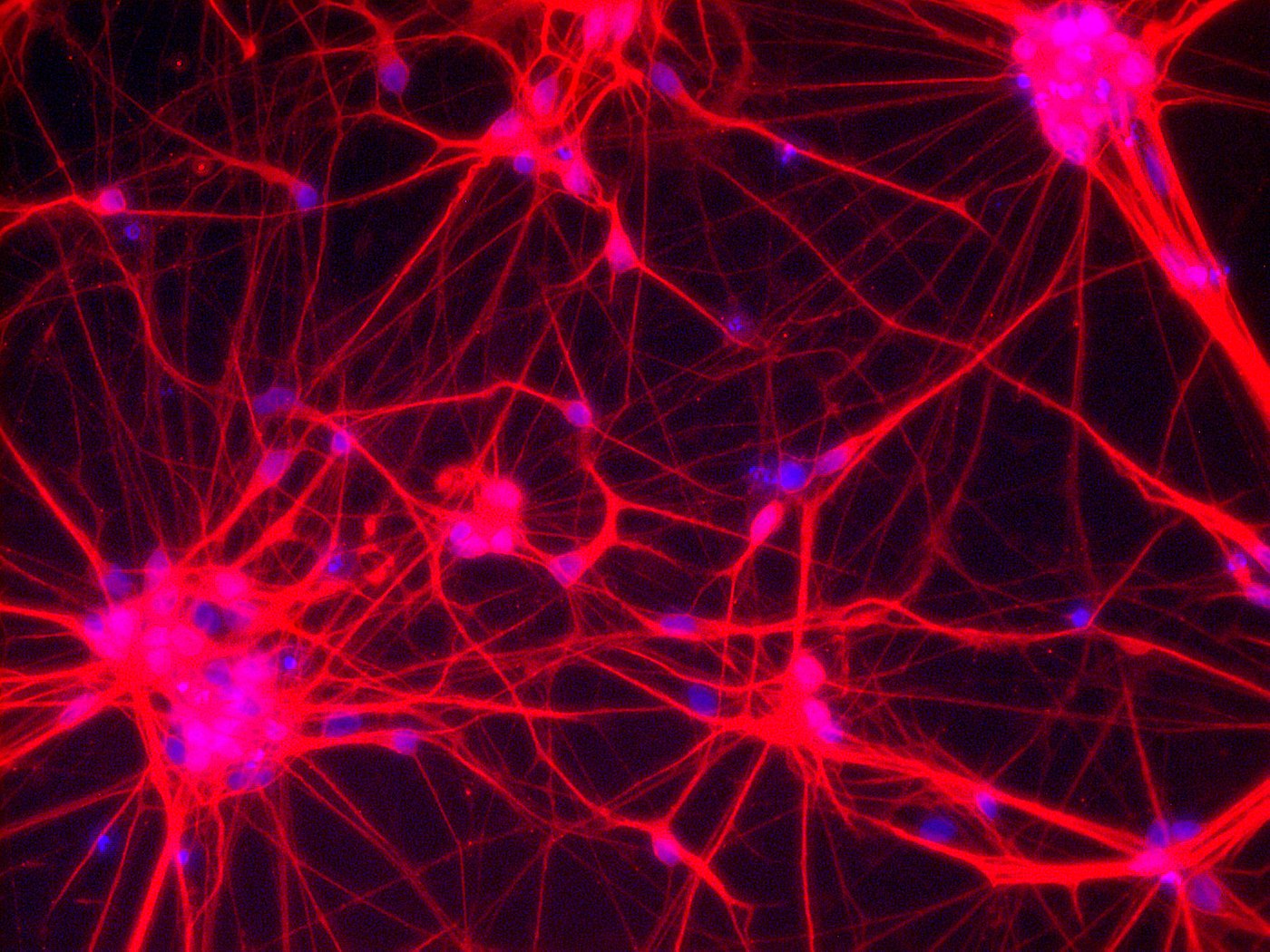
Neurons – Network of neuronal cells (Blue: nucleus; Red: neurons) [Copyright: Institute for Transfusion Medicine, UK Essen]
Translational stem cell research projects bridge the gap between fundamental research carried out in the lab and the application of this research to the field of patient care.
Who are the people behind these kinds of projects? What interests them - in their own research field, but also above and beyond that? What drives them right now?
The aim of this series is to try and make the abstract term 'translation' more tangible and to give you a glimpse behind the scenes of the world of translational stem cell research. In the fourth part of this series, we welcome Simone Haupt.
I am … Simone Haupt. I am 43 years old and I am a Biologist. I have been the head of the Bioengineering Group, Platform CELLOMICS - at LIFE & BRAIN GmbH for nine years now. I completed my biology degree at the University of Cologne. Following my degree, I worked at the University of Bonn at the Institute for Reconstructive Neurobiology in Frank Edenhofer’s Stem Cell Engineering Group on modulating stem cell properties with the aid of transducible proteins. My research focused on investigating the notch signaling pathway in pluripotent stem-cell-derived neural stem cells. After four years in Frank Edenhofer’s working group, I was given the opportunity to head the Bioengineering Group at LIFE & BRAIN GmbH. This meant a shift away from basic research towards more applied stem cell research. LIFE & BRAIN GmbH is a biomedical company based at the University Hospital of Bonn. It aims to develop new strategies for diagnosing and treating diseases of the nervous system. University-based research groups, such as the Institute for Reconstructive Neurobiology, work together with the staff of LIFE & BRAIN GmbH all under one roof, to bring about the efficient transfer of academic know-how to commercial applications. This allows scientists to be able to consistently follow developments within the company; from academic research through LIFE & BRAIN GmbH right through to a potential spin-off company. One focus of my work at LIFE & BRAIN GmbH is developing iPS-cell-based neural test systems to aid in drug discovery. iPS cells have the potential to create a practically unlimited number of defined somatic cell types in vitro. This approach is particularly relevant for diseases of the nervous system, since until now patient-specific and disease-specific cell sources have not been available for drug development for this tissue. iPS cell technology is now opening up fascinating new prospects for testing and validating active ingredients for treating neurodegenerative diseases directly in a human cell system. To be able to do this, however, a large number of cells need to be produced in standardized, industrial formats. Therefore, at the StemCellFactory project, we have gathered together the scientific and technological know-how of leading institutes and companies in the field of stem cell research and engineering in North Rhine-Westphalia, in order to develop an automated system for the industrialized production of these cell types.
What importance does the Translational Stem Cell Research competition funding have for you personally and for your work in general?Developing new platform technologies for reprogramming, sub-cultivation and differentiation of human iPS cells is a highly complex and costly undertaking with a correspondingly high development risk. Its successful implementation requires a long period of development with the appropriate level of funding. The starting point for our StemCellFactory project was successfully attracting funding from the state of North Rhine-Westphalia as part of the BioNRW2 program in late 2010. At the end of the three-year funding period, it was possible, in collaboration with partners, to set up a five-meter-long production line for iPS cell generation and expansion in the form of a demonstration unit in Bonn. The follow-on funding provided by the Translational Stem Cell Research competition was essential a) to avoid breaking off the development at this point, and b) to be able to realize the continued technical and biological developments in the platform technology necessary to allow stem cells to be used in drug development. Building on the findings documented in the StemCellFactory I project, we were able to implement the necessary technical advances, e.g. in the field of control software or integrated quality monitoring, despite the brief funding period. From a biological point of view, the research funding has allowed us to adopt process-oriented innovations from basic research. We were able to take the first steps towards implementing an automated genome editing process (CRISP/CAS9 technology) and to put into practice new bioreactor-based methods for generating standardized 3D cultures from brain and heart tissue derived from iPS cells. In the process, we have been successful in securing further follow-on funding from the current lead market LifeScience competition. Together with our new partners, LCD and BfArM, the established technology platforms will now be used to develop iPS-cell-based cellular test systems for drug testing and personalized pharmacotherapy in the field of neuropsychiatric diseases. The funding provided as part of the Translational Stem Cell Research competition has made a major contribution to the continued success of our project. Only as a result of this funding have we been able to continue working as a united team, working consistently on moving forward the developments which were jump-started almost six years.
A current scientific highlight for me … is genome manipulation using the CRISPR/Cas method. Following the first publications in 2012, which showed that specific DNA targets in microorganisms could be cut in vitro with the aid of CRISPR/Cas-Systems, the technology has matured to a molecular revolution, which affects basic research just as much as its application in medicine, agriculture and our ecology. The CRISPR/Cas method will not only change medical research, it will change all biological research in a ground-breaking way.
What else will I be doing this month aside from science … I will be spending a long, hopefully sunny weekend in Athens and possibly revising my opinion about Retsina.